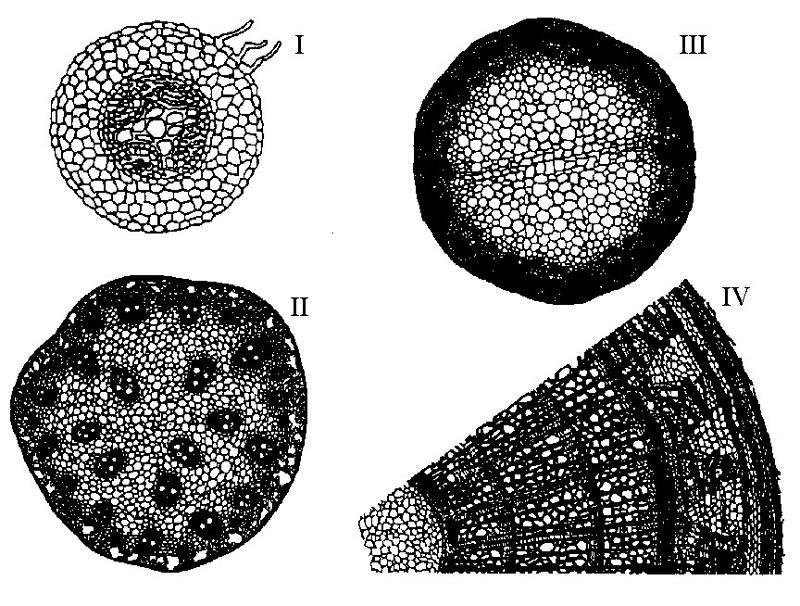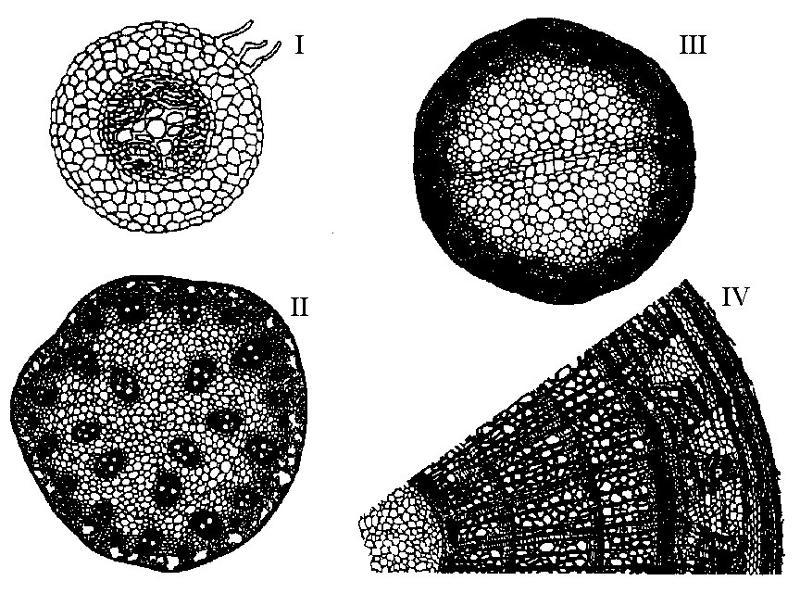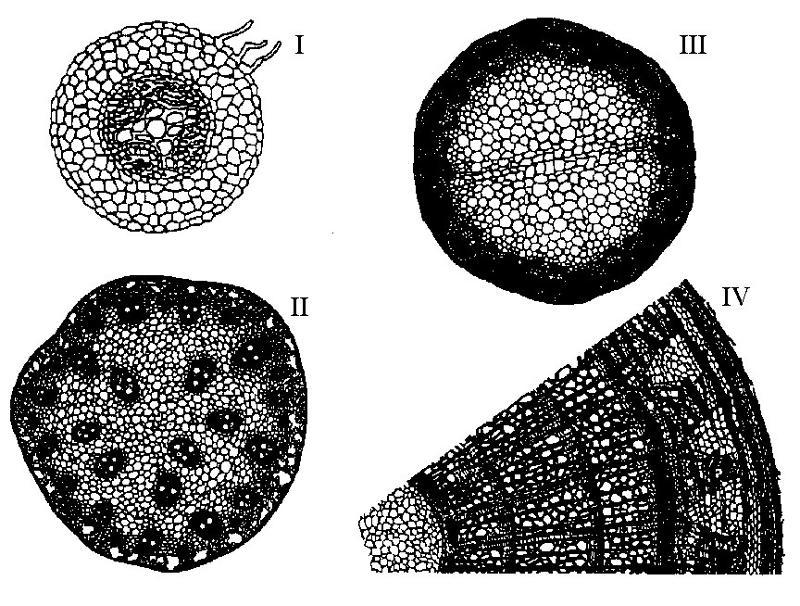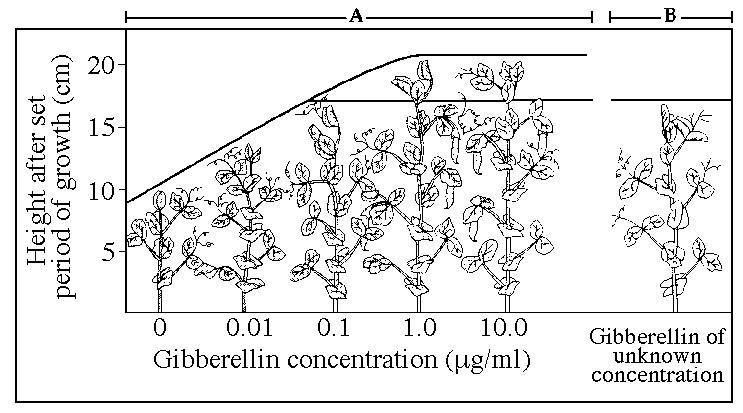One major advantage of using Arabidopsis thaliana as a model system
for studies of plant form and function is its
A) fast generation
time.
B) exceptionally large genome.
C) large seeds.
D) high tolerance to stress.
E) high mutation rate.
A
Which of the following is derived from the ground tissue system?
A) root hair
B) cuticle
C) periderm
D) pith
E) phloem
D
Which of the following have unevenly thickened primary walls that
support young, growing parts of the plant?
A) parenchyma cells
B) collenchyma cells
C) sclerenchyma cells
D)
tracheids and vessel elements
E) sieve-tube elements
B
Which cells are no longer capable of carrying out the process of DNA
transcription?
A) tracheids
B) mature mesophyll cells
C) companion cells
D) meristematic cells
E)
glandular cells
A
All of the following cell types are correctly matched with their
functions except
A) mesophyll–photosynthesis.
B) guard
cell–regulation of transpiration.
C) sieve-tube
member–translocation.
D) vessel element–water transport.
E) companion cell–formation of secondary xylem and phloem.
E
Additional vascular tissue produced as secondary growth in a root
originates from which cells?
A) vascular cambium
B) apical
meristem
C) endodermis
D) phloem
E) xylem
A
As a youngster, you drive a nail in the trunk of a young tree that is
3 meters tall. The nail is about 1.5 meters from the ground. Fifteen
years later, you return and discover that the tree has grown to a
height of 30 meters. About how many meters above the ground is the
nail?
A) 0.5
B) 1.5
C) 3.0
D) 15.0
E) 28.5
B
What tissue makes up most of the wood of a tree?
A) primary
xylem
B) secondary xylem
C) secondary phloem
D)
mesophyll cells
E) vascular cambium
B

The following question are based on the drawing of root or stem cross
sections shown in Figure 35.2.
Figure 35.2
58) A woody eudicot is represented by
A) I only.
B)
II only.
C) III only.
D) IV only.
E) both I and III.
D

A monocot stem is represented by
A) I only.
B) II only.
C) III only.
D) IV only.
E) both I and III.
B

A plant that is at least 3 years old is represented by
A) I
only.
B) II only.
C) III only.
D) IV only.
E)
both I and III.
D
Which of the following would be least likely to affect osmosis in
plants?
A) proton pumps in the membrane
B) a difference in
solute concentrations
C) receptor proteins in the membrane
D) aquaporins
E) a difference in water potential
C
A water molecule could move all the way through a plant from soil to
root to leaf to air and pass through a living cell only once. This
living cell would be a part of which structure?
A) the Casparian
strip
B) a guard cell
C) the root epidermis
D) the
endodermis
E) the root cortex
D
What drives the flow of water through the xylem?
A) passive
transport by the endodermis
B) the number of companion cells in
the phloem
C) the evaporation of water from the leaves
D)
active transport by sieve-tube elements
E) active transport by
tracheid and vessel elements
C
Phloem transport is described as being from source to sink. Which of
the following would most accurately complete this statement about
phloem transport as applied to most plants in the late spring?
Phloem transports ________ from the ________ source to the
________ sink.
A) amino acids; root; mycorrhizae
B) sugars; leaf; apical meristem
C) nucleic acids;
flower; root
D) proteins; root; leaf
E) sugars; stem; root
B
Which structure or compartment is part of the symplast?
A) the
interior of a vessel element
B) the interior of a sieve tube
C) the cell wall of a mesophyll cell
D) an extracellular
air space
E) the cell wall of a root hair
B
In plant roots, the Casparian strip is correctly described by which
of the following?
A) It aids in the uptake of nutrients.
B) It provides energy for the active transport of minerals into
the stele from the cortex.
C) It ensures that all minerals are
absorbed from the soil in equal amounts.
D) It ensures that all
water and dissolved substances must pass through a cell membrane
before entering the stele.
E) It provides increased surface area
for the absorption of mineral nutrients.
D
Which of the following is responsible for the cohesion of water
molecules?
A) hydrogen bonds between the oxygen atoms of a water
molecule and cellulose in a vessel cell
B) covalent bonds
between the hydrogen atoms of two adjacent water molecules
C)
hydrogen bonds between the oxygen atom of one water molecule and a
hydrogen atom of another water molecule
D) covalent bonds
between the oxygen atom of one water molecule and a hydrogen atom of
another water molecule
E) low concentrations of charged solutes
in the fluid
C
Cells produced by lateral meristems are known as
A) secondary tissues
B) pith
C) dermal and ground tissue
D) shoots and roots
A
Photosynthesis ceases when leaves wilt, mainly because
A) the
chlorophyll in wilting leaves is degraded.
B) flaccid mesophyll
cells are incapable of photosynthesis.
C) stomata close,
preventing CO₂ from entering the leaf.
D) photolysis, the
water-splitting step of photosynthesis, cannot occur when there is a
water deficiency.
E) accumulation of CO₂ in the leaf inhibits enzymes.
C
All of the following normally enter the plant through the roots
except
A) carbon dioxide.
B) nitrogen.
C) potassium.
D) water.
E) calcium.
A
Which of the following plant structures shares the most common
features and functions with a fungal hyphae?
A) stomata
B)
vascular cambium
C) lenticels
D) root hairs
E) prop roots
D
Most of the water taken up by a plant is
A) used as a solvent.
B) used as a hydrogen source in photosynthesis.
C) lost
during transpiration.
D) converted to CO₂.
E) used to keep
cells turgid.
C
A soil well suited for the growth of most plants would have all of
the following properties except
A) abundant humus.
B) air
spaces.
C) good drainage.
D) high cation exchange
capacity.
E) a high pH.
E
Which of the following statements is false about bulk flow?
A) It depends on the force of gravity on a column of water
B) It is driven primarily by pressure potential
C) It is more effective than diffusion over distances greater than 100mm
D) It depends on a difference in pressure potential at the source and sink
A
A person working with plants may reduce the inhibition of apical
dominance by auxin via which of the following?
A) pruning shoot
tips
B) deep watering of the roots
C) fertilizing
D)
treating the plants with auxins
E) feeding the plants nutrients
A
Which of the following soil minerals is most likely leached away
during a hard rain?
A) Na+
B) K+
C) Ca++
D) NO₃-
E) H+
D
A farming commitment that embraces a variety of methods that are
conservation-minded, environmentally safe, and profitable is called
A) hydroponics.
B) nitrogen fixation.
C) responsible
irrigation.
D) genetic engineering.
E) sustainable agriculture.
E
Which of the following would be the most effective strategy to remove
toxic heavy metals from a soil?
A) heavy irrigation to leach out
the heavy metals
B) application of fertilizers to compete with
heavy metal uptake
C) application of sulfur to lower the soil pH
and precipitate the heavy metals
D) adding plant species that
have the ability to take up and volatilize heavy metals
E)
inoculating soil with mycorrhizae to avoid heavy metal uptake
D
The bulk of a plant's dry weight is derived from
A) soil
minerals.
B) CO₂.
C) the hydrogen from H₂O.
D) the
oxygen from H₂O.
E) the uptake of organic nutrients from the soil.
B
Nitrogen fixation is a process that
A) recycles nitrogen
compounds from dead and decaying materials.
B) converts ammonia
to ammonium.
C) releases nitrate from the rock substrate.
D) converts nitrogen gas into ammonia.
E) recycles
nitrogen compounds from dead and decaying materials, and converts
ammonia to ammonium.
D
If a plant is infected with nitrogen-fixing bacteria, what is the
most probable effect on the plant?
A) It gets chlorosis.
B) It dies.
C) It is supplied with increased essential
elements from the soil.
D) It will likely grow faster.
E)
It becomes flaccid due to the loss of water and nutrients from the roots.
D
An example of a mutualistic association between a plant and a fungus
would be
A) nitrogen fixation.
B) Rhizobium infection.
C) mycorrhizae.
D) parasitic infection.
E) assisted pollination.
D
Epiphytes are
A) fungi that attack plants.
B) fungi that
form mutualistic associations with roots.
C) nonphotosynthetic
parasitic plants.
D) plants that capture insects.
E)
plants that grow on other plants.
E
Some of the problems associated with intensive irrigation include all
but
A) mineral runoff.
B) overfertilization.
C) land
subsidence.
D) aquifer depletion.
E) soil salinization.
B
Which of the following is the correct sequence during the alternation
of generations life cycle in a flowering plant?
A)
sporophyte → meiosis → gametophyte → gametes → fertilization →
diploid zygote
B) sporophyte → mitosis → gametophyte → meiosis
→ sporophyte
C) haploid gametophyte → gametes → meiosis →
fertilization → diploid sporophyte
D) sporophyte → spores →
meiosis → gametophyte → gametes
E) haploid sporophyte → spores →
fertilization → diploid gametophyte
A
Which of the following are true of most angiosperms?
A) They
have a triploid endosperm within the seed.
B) They have an ovary
that becomes a fruit.
C) They have a small (reduced) sporophyte.
D) They have a triploid endosperm within the seed and an ovary
that becomes a fruit.
E) They have a triploid endosperm within
the seed, an ovary that becomes a fruit, and a small (reduced) sporophyte.
D
The ovary is most often located on/in the
A) stamen.
B)
carpel.
C) petals.
D) sepals.
E) receptacle.
B
Microsporangia in flowering plants are located in the
A)
stamen.
B) carpel.
C) petals.
D) sepals.
E) receptacle.
A
Which of the following is the correct order of floral organs from the
outside to the inside of a complete flower?
A) petals → sepals →
stamens → carpels
B) sepals → stamens → petals → carpels
C) spores → gametes → zygote → embryo
D) sepals → petals →
stamens → carpels
E) male gametophyte → female gametophyte →
sepals → petals
D
Which of the following types of plants are incapable of
self-pollination?
A) dioecious
B) monoecious
C)
complete
D) wind-pollinated
E) insect-pollinated
A
All of the following are primary functions of flowers except
A)
pollen production.
B) photosynthesis.
C) meiosis.
D)
egg production.
E) sexual reproduction.
B
Which of the following statements regarding flowering plants is
false?
A) The sporophyte is the dominant generation.
B)
Female gametophytes develop from megaspores within the anthers.
C) Pollination is the placing of pollen on the stigma of a
carpel.
D) The food-storing endosperm is derived from the cell
that contains two polar nuclei and one sperm nucleus.
E) Flowers
produce fruits within the ovules.
B
Which of the following "vegetables" is botanically a fruit?
A) potato
B) lettuce
C) radish
D) celery
E) green beans
E
Fruits develop from
A) microsporangia.
B) receptacles.
C) fertilized eggs.
D) ovaries.
E) ovules.
D
Which of the following is a successful example of the commercial use
of transgenic crops?
A) inserting Bt toxin genes into cotton,
maize, and potato
B) developing plants that are resistant to
ultraviolet light mutations
C) producing plants that resist
attack by large herbivores
D) developing plants that produce all
the essential amino acids for humans
E) producing plants that
contain genes for making human insulin
A
Double fertilization means that
A) flowers must be pollinated
twice to yield fruits and seeds.
B) every egg must receive two
sperm to produce an embryo.
C) one sperm is needed to fertilize
the egg, and a second sperm is needed to fertilize the polar nuclei.
D) the egg of the embryo sac is diploid.
E) every sperm
has two nuclei.
C
A small flower with green petals is most likely
A)
bee-pollinated.
B) bird-pollinated.
C) bat-pollinated.
D) wind-pollinated.
E) moth-pollinated.
D
What is the first step in the germination of a seed?
A)
pollination
B) fertilization
C) imbibition
D)
hydrolysis of starch and other food reserves
E) emergence of the radicle
C
Which of the following could be considered an evolutionary advantage
of asexual reproduction in plants?
A) increased success of
progeny in a stable environment.
B) increased agricultural
productivity in a rapidly changing environment.
C) maintenance
and expansion of a large genome.
D) production of numerous
progeny.
E) increased ability to adapt to a change in the environment.
A
Charles and Francis Darwin concluded from their experiments on
phototropism by grass seedlings that the part of the seedling that
detects the direction of light is the
A) tip of the coleoptile.
B) part of the coleoptile that bends during the response.
C) base of the coleoptile.
D) cotyledon.
E)
phytochrome in the leaves.
A
Why do coleoptiles grow toward light?
A) Auxin is destroyed by
light.
B) Gibberellins are destroyed by light.
C) Auxin
synthesis is stimulated in the dark.
D) Auxin moves away from
the light to the shady side.
E) Gibberellins move away from the
light to the shady side.
D
The detector of light during de-etiolation (greening) of a tomato
plant is (are)
A) carotenoids.
B) xanthophylls.
C)
phytochrome.
D) chlorophyll.
E) auxin.
C
The ripening of fruit and the dropping of leaves and fruit are
principally controlled by
A) auxins.
B) cytokinins.
C) indole acetic acid.
D) ethylene.
E) carbon
dioxide concentration (in air).
D
Which of the following hormones is commonly used as an herbicide, such as 2, 4-D?
A) gibberellins
B) cytokinins
C) auxins
D) abscisic acid
C
If a farmer wanted more loosely packed clusters of grapes, he would
most likely spray the immature bunches with
A) auxin.
B)
gibberellins.
C) cytokinins.
D) abscisic acid.
E) ethylene.
B
The hormone that helps plants respond to drought is
A) auxin.
B) gibberellin.
C) cytokinin.
D) ethylene.
E)
abscisic acid.
E
If you were shipping green bananas to a supermarket thousands of
miles away, which of the following chemicals would you want to
eliminate from the plants' environment?
A) CO₂
B)
cytokinins
C) ethylene
D) auxin
E) gibberellic acids
C
The synthesis of which of the following hormones would be a logical
first choice in an attempt to produce normal growth in mutant dwarf
plants?
A) indoleacetic acid
B) cytokinin
C)
gibberellin
D) abscisic acid
E) ethylene
C
A short-day plant will flower only when
A) days are shorter
than nights.
B) days are shorter than a certain critical value.
C) nights are shorter than a certain critical value.
D)
nights are longer than a certain critical value.
E) days and
nights are of equal length.
D
The initial response of the root cells of a tomato plant watered with
seawater would be to
A) rapidly produce organic solutes in the
cytoplasm.
B) rapidly expand until the cells burst.
C)
begin to plasmolyze as water is lost.
D) actively transport
water from the cytoplasm into the vacuole.
E) actively absorb
salts from the seawater.
C

The results of this experiment, shown on the left of the graph (area
A), may be used to
A) show that these plants can live without
gibberellin.
B) show that gibberellin is necessary in positive
gravitropism.
C) show that taller plants with more gibberellin
produce fruit (pods).
D) show a correlation between plant height
and gibberellin concentration.
E) study phytoalexins in plants.
D
If you wanted to genetically engineer a plant to be more resistant to
drought, increasing amounts of which of the following hormones might
be a good first attempt?
A) abscisic acid
B)
brassinosteroids
C) gibberellins
D) cytokinins
E) auxin
A
Seed packets give a recommended planting depth for the enclosed
seeds. The most likely reason some seeds are to be covered with only
1/4 inch of soil is that the
A) seedlings do not produce a
hypocotyl.
B) seedlings do not have an etiolation response.
C) seeds require light to germinate.
D) seeds require a
higher temperature to germinate.
E) seeds are very sensitive to waterlogging.
C